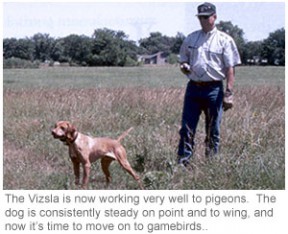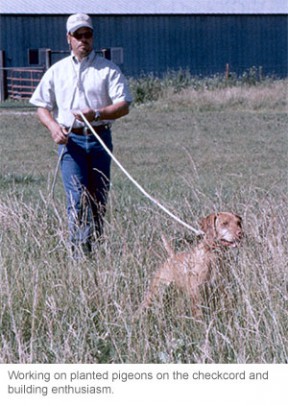



Making the Switch From Pigeons to Gamebirds



Since it's not a perfect world, what we've actually got to train in is often not much more than a backyard or a local farmer's field. Even if we're fortunate enough to have a large area to train in, the chances of it being filled with gamebirds are slim to none. If you're one of the very lucky few who are blessed with that little piece of a perfect world filled with wild birds and lots of room, we want to know where you live and if you have a spare room and some kennel space!
Without wild birds to train with, we fall back on our old standby: the pigeon. Much can be accomplished using this readily available and hardy bird.
We've already covered the whys and how-to's of training with pigeons in a previous article, so we won't get too deeply into that subject in this one. We would like to bring up a few points about working with pigeons just to bridge the gap between training birds and gamebirds.
First of all, pigeons give off loads of scent. This make it easy for a young dog to get a nose full of bird scent and helps develop prey drive and enthusiasm. Secondly, pigeons are strong flyers, making it very unlikely that a dog will catch one while giving chase. This helps develop the pointing instinct.
In addition, the fact that pigeons fly well gives a young dog a good chance to watch the flight and learn basic marking skills. Pigeons also tend to fly in easy circular patterns, making it a simple matter for a dog to watch the flight. Gamebirds (the pen-raised variety) are not usually strong flyers like pigeons, which can set your training situation up for failure. For example, say you've planted a quail for your dog to find. Your dog points the bird, you walk in to flush, the bird flies a short distance, and your dog breaks and catches the bird. This sets up a failure situation instead of success. If you correct the dog while it has the bird in its mouth, you may just leave the dog with the idea that birds are not fun. This is not the attitude we want in our dogs, so be very careful to never put the focus of training on the bird. Rather, put the focus on the infraction, such as the dog failing to remain stopped.
Let's say the above dog is being trained on a pigeon in the same situation, and breaks. Once the dog has committed to the chase, you can stop the dog to correct it because it moved, not because it chased the bird. In the initial stages of training, it's important to set your dog up to be successful and create positive habits. With a pigeon, your dog is not likely to catch the bird, allowing you the opportunity to take the chase away.
Using pigeons to train with allows a dog to learn basic skills and make their mistakes on a bird they will not be hunting. This way, if you make a mistake as a trainer, your dog will not relate your mistake to gamebirds, and it will be less likely to negatively affect your dog's training.
There is and should be a transition between pigeons and gamebirds. Use the pigeon for the traing bird, and use the gamebirds for the finishing birds. In order to use pigeons for training, the dog has to have seen one first. This means that if you will be training your dog using pigeons, start them out on pigeons. It's much more difficult to go to pigeons if a pup has been out chasing wild birds, so imprint your dog on pigeons first if that is the bird you will be using for training.
No matter how or what we train on, at some point the dog must be introduced to real gamebirds. Most often, these are pen-raised quail, chukars, or pheasants. So when to we make the switch?
The best answer we can give you is this: When the dog is broke, but not finished. We'll break that down a little further and difine the difference between broke and finished. A broke dog is one that has the basic yard work down thoroughly, and consistently leads, quarters, hunts with and for you rather than itself, and is steady on point and to flush. A finished dog means the dog is as far along in training as you will ever want it. For some, a finished dog will honor and is steady to wing but allowed to break on shot. For others, a finished dog must be steady to wing, shot, fall, honor, and also retrieve to hand.
Whatever your personal definition of finished may be, gamebirds will be used for the finishing work. Before making the transition from pigeons to gamebirds, be certain your dog is at the broke stage of training and knows exactly what it is supposed to do all the time, and in varied locations. When all the basic work is correct, it's time to move on to gamebirds.
Often, when dogs are about at the transition stage, they may become bored with pigeons. When this happens, you can liven things up by carrying a couple of spare pigeons with you, and if the dog lacks intensity, you can toss a bird or two out in front to make things more exciting.
Be very aware of the game laws in your state when you make the transition to gamebirds. Getting fined for training your dog during nesting season when wild birds are off-limits can take the fun right out of things! Your local warden should be able to tell you what kind of permit if any you will need, and help you with the regulations.
For example, in Wisconsin, gamebirds used for training that are not on a licensed game farm must be tagged before they are released and used for training, and a dog-training license is required and must be on your person while training using game. Be sure to find out what your local requirement are.
As you make the change from pigeons to gamebirds, keep a few things in mind. First of all, scent conditions are important. If you have less than desirable scent due to dryness, for example, then use pigeons to train. They give off more sent, and your session will be more productive. Secondly, don't make corrections on birds in general, including pigeons, and especially don't make corrections on gamebirds. We've said it earlier, but once again would like to emphasize to never put the focus of the training or the correction on the bird. Go back to pigeons if you need a refresher course to tune your dog up a bit. Dogs tend to get stale on the birds they train on, and it's far better to have a dog get stale on pigeons than on quail or pheasants.
Catching birds in not a good thing, unless you need to develop prey drive. If your dog catches one gamebird, it's not the end of the world. What it does tell you is that you need to go back and review the basics and get your dog to stand still. This should be done using pigeons for two reasons. First of all, you don't want the dog to relate a correction to birds in general, much less gamebirds. Second, your dog is very unlikely to catch a pigeon, so you've set up a success situation.
The more the dog catches birds, the less they want to point! They lose their stalking instinct and charge on in every time they wind a bird. The best way to prevent this is to not set up a situation where it can happen, and that means being sure your dog is thoroughly broke using pigeons before moving on to gamebirds.
This brings us to anotehr point about training. Some of the time when you change over to gamebirds, you have less control over the training situation because you may not be using launchers, etc. The situation is not in complete control. So it's important that you be certain you and your dog are ready, and that your dog is at a stage in training where you won't need as much control over the bird as you would with a hobbled of launched pigeon.
When using pigerons, often your scent gets on the birds because they are handled so much. When you switch to gamebirds, be careful to handle them as little as possible so your scent will not factor into the training equation. This way, when you move from pen-raised game to wild birds, your dog will not be looking for your scent to show them the way.
If you plan to finish your dog all the way through retrieving work, it's a good idea to use pigeons for the part of the training. They are much stronger and can take more use than most gamebirds.
Taking the step from training on pigeons to working on gamebirds is a thrilling part of the process. This is when the lightbulb really comes on for many dogs, and you will see an intensity and fire in your dog that will make all the hard work worthwhile. To keep this intense excitement, always be sure to stop each training session with a success. When you've set up a bird-training situation and your dog did so well that you say to yourself, "That was awesome - it was so much fun, let's do it again,"resist the temptation and put the dog up for the day. This leaves your dog thinking about success and also wanting more. If you take the gamble out of doing it over and over in the same session, you may not have the same successful experience, and this takes something away from the training. Quit while you're ahead.
Come fall, when your dog makes that first brilliant point on a wild bird, all your time spent training pays off big time. Enjoy it!